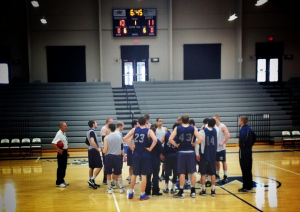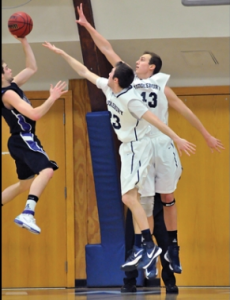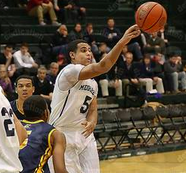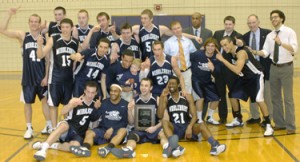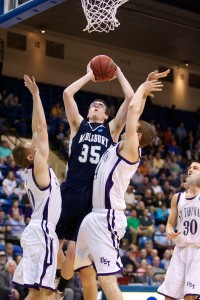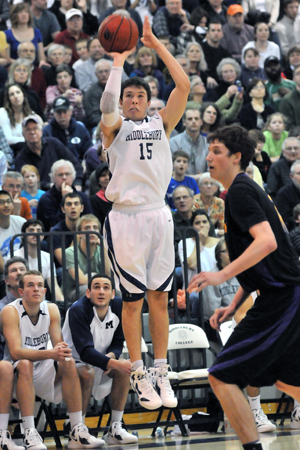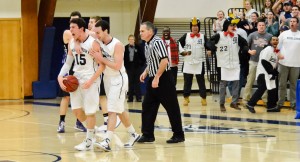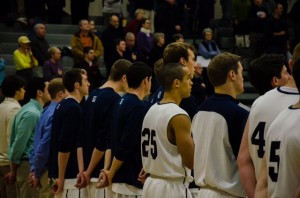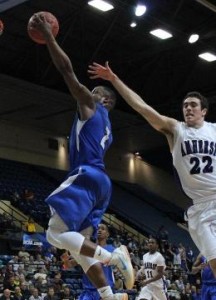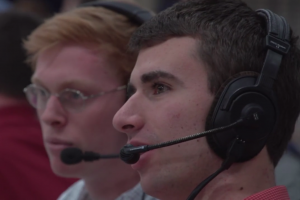Dear readers,
Below is our farewell post, in which we review our four years of broadcasting, coverage, and fanhood. Both of us have graduated from Middlebury, and the Panther Nation blog is graduating with us. This piece is both personal and analytical. We thought it was worth articulating some memories and reflections, but the bulk of the post is analysis. We hung our hats on our ability to answer complicated questions thoughtfully and thoroughly, and to convey our observations as insightfully as possible. We hope you found our work edifying, and we hope this post follows form. See you at Pepin, Chander, LeFrak, et al.
Thanks for reading,
Jeff and Damon
•••
Before last season, we projected a 20-4 regular season, a third place finish in the NESCAC, and an NCAA tournament berth. Middlebury went 17-9, finished third in the NESCAC, lost in the NESCAC semifinals, and did not qualify for the NCAA Tournament. What happened in 2013-14 to explain the discrepancy between performance and expectations?
JH: Several factors came into play, or had stronger effects than we expected. Injuries to Matt Daley and Matt St. Amour certainly played a role. We repeatedly highlighted these two opening-night starters as keys to the season, and both missed the last chunk of the year. Both also played games well below full strength before that. Daley was the second best player on the team when he was fully healthy, and once his interior scoring presence was gone, there was nobody to fill the void.
The inability to cope with the loss of Nolan Thompson defensively also stood out. Middlebury allowed 6.1 more points per game this season than last. Nobody was left to fill that defensive blue-chip role that Nolan Thompson, Andrew Locke, and Tim Edwards had made a staple of the Middlebury basketball brand.
The other reason this team didn’t excel, from my limited perspective, was lack of chemistry. We were spoiled with some teams that nailed this element of success, and for whatever reason, I got the impression that it never came together for the ‘13-’14 Panthers. This isn’t an indictment of personal character; it is an observation of an on-court product.
DH: Last season just never got off the ground for Middlebury. It started with a grueling schedule, was made worse by a bad-weather detour and was topped by a rash of season-defining injuries, illnesses and absences. Jeff is right to highlight the lack of chemistry and it may have been an issue of personalities, but I also believe this team was put in difficult situations while almost never at full strength. In a conterfactual world where Middlebury plays an easier non-conference schedule with considerably less travel and they start 9-2 rather than 6-5 do they gel and find an identity? Is it enough to convince the NCAA that Middlebury is deserving of an NCAA Tournament berth? Of course this was not the case, but there were a number of reasons why Middlebury’s season never came together the way we hoped it would.
What was the best moment from the ’13-’14 season?
DH: Unfortunately this is kind of a tough question. The best moment was probably at halftime of the first Williams game, which was precisely the problem. So, instead I’ll opt for Middlebury’s 89-84 win at Skidmore, when the Panthers went into a hostile environment on the road and withstood numerous late runs from a talented Skidmore team. Matt St. Amour and Joey Kizel were both exceptional, combining for 51 points on 16 of 24 shooting. Heading home from Saratoga Springs following the final game of the fall semester, it seemed as though Middlebury had finally found its stride. As we know now, they never really got back there.
JH: A few candidates: Matt Daley’s dominant 24 and 11 in the season-opener, St. Amour’s 27 in Saratoga, Jensen’s defense on Duncan Robinson in the first Williams game, Kizel’s shooting streak in the first half of the second Williams game, Dylan Sinnickson’s game-winner against Connecticut College.
But the first thing that came to mind was the first half against Bates, when Dylan Sinnickson—who we were worried might be gone for the season—returned to the court and shot the lights out. He had 17 points in 13 minutes, and shot 3-4 from behind the arc. Despite the second half collapse, I won’t soon forget the energy and optimism that Sinnickson provided in those twenty minutes. The ultra-athletic junior was a great story: his status was up in the air after missing all of last season (and even more so after his fall respite), but hecame back after winter break with an unstoppable outside shot. The last time we had seen Sinnickson in game action was as his freshman year when he made zero three-pointers in 342 minutes; we thought he was kidding when he told us in our preseason radio interview that he expected to take four three-pointers per game as a junior. He ended up taking six per game, and hitting them at a 43% rate. It’s so much fun to see a player work hard to improve their game; Sinnickson did that, and the Bates first half was his coming-out party.
What was the biggest surprise or the best story in the conference in ’13-’14?
DH: Bowdoin was clearly the surprise of the NESCAC. The Polar Bears’ start to the season would have been surprising even with a healthy Bryan Hurley. Of course Bowdoin’s soft non-conference schedule helped them considerably, but nonetheless winning 12 straight games to start the season is a remarkable feat and Tim Gilbride’s team never lost a game by more than six points all season. Competing every night is harder than it sounds and Bowdoin’s resilience all season long in the face of injuries was one of the NESCAC’s best and unforeseen storylines.
As for the biggest story, Williams’ seesaw season—at least relative to our meteoric expectations for the Ephs—is the obvious choice for me. Entering the season we projected Williams to win the NESCAC and compete for a national title. But entering the NCAA Tournament, Amherst was once again the class of the conference and had beaten Williams three times. And then the Ephs caught fire, stampeding their way through the NCAA Tournament en route to Salem. Heading into their Final Four showdown with Amherst, Williams had won four games by an average of 21 points, including a 33-point victory over Mary Washington at Mary Washington, in which the Ephs held the hosts to 46 points. But Williams still had to beat Amherst to live up to the preseason expectations. Again, it wasn’t so much that Williams won, but how they beat the Lord Jeffs—a 29 point thumping that made Amherst look toothless and eager for the game to end for much of the second half. Ultimately it didn’t end in a national championship for Williams (who is no stranger to heartbreak in Salem), but during that stretch of five games the Ephs went from underachievers to exceeding even my lofty expectations before the season began.
JH: Williams obviously surprised a lot of people by making the national title game, but we projected them as a national title favorite before the season. I was the most impressed by how Amherst bounced back from losing Willy Workman, Peter Kaasila, and Allen Williamson. That grouping was arguably better than Middlebury’s Wolfin-Lynch-Thompson graduating trio, and the Lord Jeffs barely declined en route to their third consecutive conference title and a national semifinal appearance. Aaron Toomey took huge strides as a player, eliminating inefficiencies from his game, creating more opportunities for his teammates on offense, and creating turnovers on defense. Toomey’s supporting cast deserves a lot of credit as well, as David Kalema, Connor Green, and especially Tom Killian all stepped into bigger roles and proved they belonged. David Hixon’s ability to make the most of the immense talent that Amherst brings in every year is remarkable. I wonder if they would have won another national title had Ben Pollack stayed healthy.
How will Middlebury fare in the upcoming season?
JH: The return of a healthy St. Amour and Daley will be a major benefit, but I struggle to see the talent coming together into a cohesive whole in time for next year’s team to be blossom. The on-court chemistry will depend largely on the progress of rising sophomore point guards Jake Brown and Bryan Jones, and it would not be surprising if those two take big jumps forward. Freshman Jack Daly is an early candidate for serious playing time, and the talent is there for an elite cast of ball-handlers and distributors. If that is the case, St. Amour, Merryman, Sinnickson, and Daley could shine as they all have what it takes to be potent offensive complements. I think this team could do a lot of damage with Merryman, Sinnickson, and Daley at the 3, 4, and 5 because it opens the floor for penetrating point guards (and brings post defenders out of their comfort zones against big guys who can shoot and drive). When they turn to a traditional look, Daley will need to score and facilitate consistently in the post; depth down low remains elusive.
I peg the conference win line at 7, and the NCAA tournament odds at 3:1.
Let’s dive a little deeper and project a depth chart heading into next season, incorporating the freshmen recruits with obviously limited information about their abilities.
1: Jake Brown, Jack Daly, Henry Pendergast
2: Matt St. Amour, Bryan Jones, Liam Naughton
3: Hunter Merryman, Dean Brierley, Jack Gale
4: Dylan Sinnickson, Connor Huff, Jake Nidenberg, Adisa Majors
5: Matt Daley, Chris Churchill, Nick Tarantino
Most of those top reserve spots are going to be decided by early performances. I don’t think anyone on the team outside of the starting five above is a lock for substantial rotation minutes. A lack of rim protection stands out, unless Churchill takes a substantial step forward with his footwork and spatial skills. Each of the starters has the potential to be a star: Brown, St. Amour, Sinnickson, Merryman, and Daley have showcased their talent in spurts. Jones was one of the best players on the court in the few opportunities he saw last year—a plus ball-handler and shooter, who could fill a modified Kizel role next to Brown’s Wolfin. Brierley is a 6’5” guard who can shoot and play physical defense. Pendergast is long and athletic for a combo guard, and could shine if he stays injury-free. Naughton will find a way to make a positive impact wherever he ends up, which might be with some well-earned playing time. Huff can score in a lot of ways but didn’t take the sophomore jump I anticipated last year. Nidenberg has a big body and knows how to use it to his advantage, and should benefit from a year of experience down low. I look at the jump that John Swords made last year as a junior and wonder if Churchill could do something similar this year, as his game is about as refined as Swords’s was at the end of his sophomore year. The ceiling is obviously lower given Swords’s three-inch height advantage, but the senior could emerge as a reliable post scorer.
Without being at practice, it is hard to get a read on a few crucial factors: does this group of players, generally speaking, love competition and/or basketball? Do they embody this attitude and bring it out of each other. This will go a long way toward determining whether the potential is fulfilled. Constructing and maintaining a winning identity is a major undertaking, and I do not expect that we will see a polished product.
DH: Middlebury is young and talented, but largely inexperienced. Dylan Sinnickson and Hunter Merryman are the only returners with considerable postseason experience. The Panthers are talented offensively, but lack defensive size and depth. This could be especially problematic this year with the shifting landscape in the NESCAC. Guard play has dominated conference play over the last three years, but an influx of skilled, physical big men leaves Middlebury looking thin in the frontcourt. The spotlight will shine particularly bright on Matt Daley who will have to put the (extraordinarily talented) pieces together and prove that he is Middlebury’s next great big man. He is capable of doing all of the things that the team will require on both the offensive and defensive ends. But being a dominant two-way player requires as much discipline as it does talent. It means staying in shape, healthy, out of foul trouble, engaged on both ends of the floor despite contact, lack of calls and long stretches of time without seeing much of the ball. Playing without the ball is just as important—and often more difficult—as what you do with the ball in your hands. We can’t pin a team’s hopes on a single player, but if Daley can be one the league’s best big men next season it will go a long way towards Middlebury’s postseason hopes.
Middlebury’s competitive advantage vis-a-vis the NESCAC will be its ability to run the floor and transition quickly from defense to offense and offense to defense. Given the lack of frontcourt size and depth, the Panthers will rely more than ever on their ability to force turnovers and run in transition. Jake Brown, Dylan Sinnickson and Matt Daley are perhaps the fastest players in the NESCAC at their respective positions, while Merryman, St. Amour and Brierley are savvy at creating space and can all shoot from distance. With Jake Brown at the point and a bevy of talented guards — St Amour, Bryan Jones and newcomer Jack Daly are all immensely talented — and athletic wings, Jeff Brown has all the tools he needs to employ a full court press and an extended, pressure defense in the half court.
Envisioning a team that presses full court and gets easy baskets in transition is fun to think about, but even if it turns into reality, coach Brown will likely need to cultivate a more traditional lineup that can operate in the half court and get defensive stops at a less-than-frenetic pace. Finding a reliable big to partner with Daley will be essential, therefore. Given Daley’s face-up game and ability to shoot the three, he could pair well with Chris Churchill in a bigger lineup, while Nidenberg and newcomer Nick Tarantino would give Middlebury better spacing and scoring, if losing some size and rim protection. Tarantino is skilled, and should eventually develop into a multi-threat offensive player and strong rebounder, but projecting immediate contributions from first-year big men is difficult.
With a young roster and questions about chemistry and fit, I think your wins line and title odds are just about right. If Middlebury does win seven NESCAC games I think that will be good enough for the second seed in the conference tournament. Even with another great Amherst recruiting class, there is going to be a much bigger middle class in the NESCAC next year and it will be teams at the top sacrificing wins. It also means that there is going to be ample opportunity for a team to grab a spot at the head of the NESCAC table. If the Panthers put all the pieces together, it’s certainly possible they take the throne back.
What’s your long term (2-5 years) prognosis for Middlebury?
JH: In five seasons from 2008-13, Middlebury went 128-18 with five NCAA tournament berths, four NESCAC championship games, and two NESCAC titles. They rode five superstars—Ben Rudin, Andrew Locke, Ryan Sharry, Nolan Thompson, and Joey Kizel—to that success, complemented by consistently great supporting casts, and those teams loved to play together. It was special, and it might be unreasonable to ever expect it again.
But the program has the ingredients for some very good teams, and I would not be surprised to see them in the national conversation for each of the next four years. In a year, I could see them thriving with the Brown-Jones-Daly-St. Amour backcourt and Daley down low. That’s a core that could win a NESCAC title. I see First Team All-NESCAC players in St. Amour and Jake Brown. I then expect the current rising sophomores to form a great leadership group during their senior season, and believe in the coaching staff to continue to bring in and coach up talent. We have reason to be optimistic about the 2018 recruiting class as well. I predict one NESCAC title and one more title game, plus two or three NCAA tournament berths.
DH: Middlebury’s rise to the top of the NESCAC does not appear to be a short-lived phenomena. While the Panthers may again be inconsistent in 2014-15, Jeff Brown (driven by lead assistants Alex Popp and Kyle Dudley) has had back-to-back strong recruiting classes — with a third likely in the works.
The rising sophomore class reminds me of the 2013 class, both from a talent point, but also in the quiet confidence—and sometimes cockiness—that they exude. Brown, St. Amour and Bryan Jones complement one another’s games as well as one another’s personalities. Chemistry is a fickle thing; just having players with complementary skills or who get along off the court isn’t enough. How those three come together, and how the recruiting classes of 2013 and 2014 develop, will define Middlebury’s future. If things go well, Middlebury could enjoy another four-year run over that stretch (2-5 years from now) as a NESCAC title contender and a third trip to Salem (second Final Four). It is always hard to predict these things, but you get the feeling that there is something building with this sophomore class with an influx of talent arriving behind them.
What year was the best Middlebury team of the past four years?
JH: For the record, we’ve been asking each other this question since our sophomore years. The question comes down to ‘10-’11 vs. ‘11-’12. If we were asking which team accomplished more, it would obviously be ‘10-’11: a NESCAC title and a national semifinals appearance vs. a NESCAC runner-up and a Sweet Sixteen ousting. But the question of which team was better is a way of abstracting the team from its circumstances (there is something wrong with doing that when it comes to understanding sports, because all value in sports derives its meaning from the result, i.e. winning, but abstraction is instructive to a degree). The question is: Which team would have had an average better result if they played enough seasons to eliminate randomness?
There is a very good argument to be made for the ‘11-’12 team, which was ranked first in the country for the better part of two months, and which was a national title favorite until the season ended on the still-gut-wrenching Travis Farrell buzzer beater. That team was probably the best in Division III, riding two elite offensive stars in Ryan Sharry and Joey Kizel, flanked by an ideal supporting cast of Nolan Thompson, Jake Wolfin, and Peter Lynch.
Sharry was the best player in the country that season, averaging 18.8 points, 10.3 boards, 2.0 assists, 2.0 blocks, and 1.0 steal per game, on a fantastic 61/43/67 shooting pace. Kizel broke out with 14.0 points per game, 3.9 assists per game, and 54/51/91 shooting. Throw in Thompson’s shutdown perimeter defense, Jake Wolfin’s masterful orchestration of the point, and Peter Lynch’s NESCAC-leading 64% field goal shooting, and you have a historically good team. Dylan Sinnickson was already a very reliable mid-range shooter and James Jensen made plays every night off the bench. They beat a lot of great teams with relative ease and seemed to never hit their stride fully. It took an 0-10 shooting start from Wolfin and Thompson, disorienting officiating, Sharry foul trouble, and Scranton shooting the lights out to eliminate the ‘11-’12 Panthers (on a 30-foot buzzer beater).
But that ‘10-’11 team was even better, I believe. Kizel and Sharry were not yet offensive machines, but with Andrew Locke and Jamal Davis added to the equation, they did not need to be. That team’s defense was suffocating. With Thompson on the perimeter, and Davis-Sharry-Locke down low, opponents shot 34.7% from the field, the lowest opponent’s field goal percentage allowed by any defense in the country this century. Opponents totaled 56.3 points per game. I have never enjoyed anything as a basketball fan as much as I enjoyed going into every game knowing my team had Andrew Locke down low. His individual stats—4.2 blocks in under 25 minutes per game—still do not convey the effect that he had on opponents. Every great penetrating guard had to alter or abandon his shot to avoid Locke’s reach, and every great big man was a shell of his typical self. Locke was huge and athletic, of course, but his reaction, anticipation, defensive awareness, and body control were breathtaking. That he does not get mentioned alongside the best NESCAC players of this generation speaks to an analytical defect when it comes to interpreting defensive value. Sharry and Davis added a combined 3.1 blocks and 1.9 steals per game. We owned the paint.
The offensive was pretty good, too. Sharry and Locke—an impossible 6’8” and 6’10” duo to defend—led the team in scoring, shooting 51% and 64% from the field respectively. Locke was by far the best dunker I have seen in Division III, in that he got up fast and finished over or through opponents with ease. (Dunking is an underrated skill since it has become associated with flashiness instead of productivity.) A signature offensive play for the ‘10-’11 Panthers was a Kizel or Wolfin drive that drew help, allowing a quick dish to Locke for the slam. Outside of the big men, you had Thompson, Ryan Wholey, Wolfin, Kizel, Davis, and Lynch. Those six combined for 45 points per game, and the first three combined for 114 three pointers made on 35% outside shooting. The role players were young but mature, and they usually out-competed (and often embarrassed) the veterans they went up against. Jake Wolfin’s 5.0 assists per game led the conference. As a team, Middlebury shot 48% from the field. A very good offense and one of the best defenses in Division III history is a combination that few teams can beat, and indeed, that team only lost twice—once in the final 30 seconds on the road to eventual national semifinalist Williams in a game that Ryan Sharry missed, and then to the eventual national champion in the Final Four by one basket. Long stretches of total dominance against national favorites—the second halves against Amherst, Williams, St. Mary’s, and Rochester—were indications of Greatness. The ‘10-’11 team was so good that it lost two games and I would expect that number to drop if they replayed the season. We were lucky to have that team, and I would take it over any team I have ever seen in Division III basketball.
DH: Of all the Middlebury-basketball related questions this has to be my favorite. I’ve gone in many directions trying to answer this question, but I think I’ve finally settled on a team. Since Jeff has made the statistical cases for both teams, I’ll limit my answer to what I think is the biggest difference between the two teams: ability to finish. The 2010-11 team’s ability to defend without fouling down the stretch, (while relying on Kizel, Wolfin and Sharry to make plays) was unique to that team. Ever since the departure of Andrew Locke Middlebury has struggled to hold leads late in games and even that ‘11-’12 team was not immune.
The biggest edge that the ’11-’12 would have is ability to get stops and score on the break. Given that the ’11-’12 team held opponents to 38 percent shooting—easily the best mark in the NESCAC—it’s not a stretch to imagine that they would match up pretty well with the ’10-’11 team defensively. And no team that we saw that season—nor any Middlebury team before or since—was better at turning missed shots into points in transition.The other argument in favor of the ’11-’12 team is free throw shooting. The “Sharry-Locke” team was horrendous from the free throw line, making less than 66 percent of their attempts. In contrast, the “Sharry-Lynch” team converted better than 75 percent of their free throws.
Of course free throw shooting, both positive and negative factored into their point differentials +16.4 and +16.0 for the 2010-11 and ’11-’12 teams, respectively. And then there’s what we know from watching these two teams: the ’10-’11 team did not surrender leads late. There was no solution to their dominant defense as they stayed out of foul trouble and managed to find enough points offensively to maintain, or often extend, leads. While the ’11-’12 team was almost the offensive equivalent to the ’10-’11 team, the offensive production disappeared for stretches—particularly late in games—in a way that never happened with the ’10-’11 team’s defense. Particularly against Keene State, but also with Scranton the ’11-’12 team had too many instances of offensive droughts to be considered ahead of the ’10-’11 team, which finished two games better than the ’11-’12 team and translated that to a NESCAC title and a Final Four berth.
Which Middlebury player (in the past four years) had the best career?
JH: There are four contenders here, the headliners of the four senior classes we saw play: Locke, Sharry, Thompson, and Kizel. Wolfin has a clear hold on fifth (those are five of the top six minutes-getters for the ‘10-’11 team, by the way). Let’s compare the contenders, broken down into their four years of contributions (this is worth a close reading):
Freshman year
- Locke: 2.1 points, 2.0 rebounds, 2.1 blocks, 42/(1-1)/42 shooting (8 mins)
- Sharry: 7.7 points, 5.4 rebounds, 1.5 blocks, 57/0/69 shooting (18 mins)
- Thompson: 10.2 points, 3.0 rebounds, 0.8 steals, 42/31/84 shooting (28 mins)
- Kizel: 8.1 points, 3.3 rebounds, 3.5 assists, 0.7 steals, 45/35/76 shooting (22 mins)
Sophomore year
- Locke: 7.8 points, 5.9 rebounds, 3.4 blocks, 59/0/47 shooting (22 mins)
- Sharry: 13.7 points, 8.1 rebounds, 1.6 blocks, 1.3 steals, 53/41/75 shooting (26 mins)
- Thompson: 9.8 points, 3.8 rebounds, 42/40/80 shooting (31 mins)
- Kizel: 14.0 points, 3.9 assists, 3.2 rebounds, 0.7 steals, 54/51/91 shooting (30 mins)
Junior year
- Locke: 9.1 points, 5.0 rebounds, 3.9 blocks, 61/(1-1)/40 shooting (24 mins)
- Sharry: 13.7 points, 10.5 rebounds, 2.1 blocks, 1.0 steals, 52/32/75 shooting (27 mins)
- Thompson: 9.3 points, 4.1 rebounds, 1.9 assists, 0.7 steals, 44/34/81 shooting (31 mins)
- Kizel: 14.3 points, 4.3 assists, 3.9 rebounds, 1.6 steals, 49/43/79 shooting (34 mins)
Senior year
- Locke: 9.9 points, 7.6 rebounds, 4.2 blocks, 64/0/36 shooting (25 mins)
- Sharry: 18.8 points, 10.3 rebounds, 2.0 blocks, 1.0 steals, 61/43/67 shooting (30 mins)
- Thompson: 12.4 points, 5.1 rebounds, 1.0 steals, 48/43/79 shooting (34 mins)
- Kizel: 16.6 points, 5.6 assists, 5.0 rebounds, 1.8 steals, 44/43/81 shooting (35 mins)
Stats never tell the whole story, and that is especially true in the cases of Locke and Thompson. How many points per game did Thompson’s perimeter defense or Locke’s interior presence save? We don’t know, but defensive presence makes up a substantial component of value for both of those players. Taking that into consideration, it is a close race.
Kizel had three seasons above 14 points per game, was exceptionally efficient, and dished out the second most assists in school history. Sharry had the best single season (his senior year) and an amazing all-around game, combining efficiency with offensive, defensive, and rebounding production. Thompson took out opponents’ top perimeter threats night-in and night-out, played 28+ minutes per game every season, and was a consistent presence on offense with composure, ball-handling ability, and outside shooting. Locke scored down low consistently, blocked a shot every 5.8 minutes of his career, and altered about every third shot the opponent took.
After looking at those stats for a long time, and considering how each player contributed to the team in various ways, it seems like Sharry tops the list. He could do it all, and he did it all at an incredibly high level. He was simultaneously the best low-post player and one of the best shooters in the conference. He was a major presence in the paint and on the boards. His game was better developed than any player I’ve seen in Division III. With Ryan Sharry on the floor, the offense had so many options, and so much more space within which to operate. He was the best player of the Middlebury golden years.
By the way, these Sharry highlights and Locke highlights are worth your while.
DH: Again, Jeff has done a great job providing the statistical argument for all four of these guys. So I’ll take a shot at determining the best way to interpret “best career.” One reason I want to think about how best to understand “best” is because there is no clear statistical choice.
What is most important to an outstanding career? Year-to-year consistency? Demonstrating improvement every year? Maximizing talent? Setting records? Winning games? Proving at your peak that you are the best player?
Thinking about each of these four guys you can put a name (or a couple) next to each attribute. Kizel, Thompson and Sharry were impactful from the get go, though Kizel probably has the strongest case here. You could argue all four players demonstrated improvement every year, but Sharry and, in particular, Locke have the strongest claims there. Locke, Thompson and Kizel all maximized their talent. Locke obliterated the blocked shots record. Thompson and the class of 2013 are the winningest in Middlebury history, though no player had a bigger impact on close games than Joey Kizel. And Ryan Sharry’s senior season was National Player of the Year worthy.
And what about the biggest critiques of each player? Locke was a truly awful free throw shooter, was an offensive liability his freshman and sophomore seasons and never averaged more than 24.5 minutes per game in a season. Thompson was never more than a complementary offensive player who played shutdown defense on the opposing team’s best defensive player, but did not create turnovers, instead forcing the ball elsewhere. Sharry disappeared at times offensively, particularly on the block against bigger defenders, making him an unreliable option at times late in games. And Kizel had his best seasons playing off the ball, when he could pick his spots and operate in advantage situations. As a senior, when asked to play on the ball and provide for others while creating for himself, Kizel had his least efficient season in three years and appeared to run out of gas in Middlebury’s final game of the season against Williams.
Again, there isn’t a clear choice here, which speaks to how good all four players were. To me, it comes down (dangerously) to something that can’t be particularly well quantified: which player helped Middlebury win the most games? Because I think it’s next to impossible to differentiate the four players based on their stats or career arcs, I can only say that from watching all four extensively I’ve concluded that Joey Kizel had the best career. I would have a really hard time making a strong argument against any of these players, but from all the time I spent watching this team, I think the answer is Joey.
Who was the most fun player to watch?
JH: It’s a tie between Locke and Thompson for me. Kizel was magical far more frequently than could be explained, and Sharry came straight out of a video game, but defense is where my heart is. The way Locke moved down low—anticipating, reacting, attacking, and rejecting—was surreal. And Thompson just never got beat, an ability that grew in perceived importance the more you watched him play. As the color commentator during our broadcasts, I had freedom to look off the ball, and I loved spending defensive possessions watching Thompson’s man run him through picks trying to get open, receiving the ball rarely and always out of position, then running into Thompson attempting to drive by him, before giving it up. The number of picks Thompson made invisible, the number of sets he rendered fruitless, the number of opposing stars he ran into the ground… it was constant superiority. I really appreciated that he excelled at something so alien to glorification. That’s the kind of player you never forget.
DH: I have a true appreciation for defense — though I didn’t have as much of a chance to watch Nolan or Locke move off the ball — but to me there is nothing more exciting than making a play with the game on the line. And no basketball player I have ever watched did this better than Joey Kizel. He thrived in the biggest moments of the biggest games, when his team needed him most almost without fail. Like the alpha dog in a pack, Kizel’s teammates put him in position to make the game’s biggest plays and time and time again Kizel came through with the kill. Purely off the top of my head the following moments come to mind:
- The backcourt strip of Aaron Toomey and and-one layup in the final game of the conference schedule in 2012 to determine home-court advantage in the NESCAC that gave Middlebury life. (Possibly my favorite Kizel play ever: against Toomey, on the road, in the most important regular-season game of the year that rallied Middlebury to force overtime.)
- Tying the game against Scranton in the 2012 Sweet 16. Kizel’s effort in that game was tremendous and that play should have ultimately led to a Middlebury victory. The curse of Kizel was how many of these plays came in losing efforts.
- Triple-overtime versus Amherst in 2013. Kizel makes a three late in the second half to bring Middlebury within two possessions. On the subsequent possession, Kizel cheats off of Toomey, strips Workman and dives on the floor to get the loose ball while calling timeout. I’ve never seen a crowd respond to a play like that. I believe that following that play the entire crowd remained on its feet for the end of regulation and each of the three overtimes.
- The game-winning free throws against Ithaca in 2013. It was so close to being Scranton 2.0. Middlebury was moments away from losing to an inferior team at home. After a made basket, just like against Scranton, Kizel was the first to react, already turning up court as he caught the inbound pass and making a play before the defense could react.
- The game-tying three against St. Mary’s in the first month of the 2013-14 season. Middlebury was playing then-top 10 St. Mary’s as part of their brutal opening schedule. With Middlebury down three, the ball was swung to Kizel in the closing seconds and, knowing exactly how much time he had left, he took a dribble to his right away from the defense, pump faked to get his too-fast closing defender up in the air, stepped forward and launched a game-tying three.
And there are so many more. I’ve truly never seen a player (Michael Jordan predates my days as a real basketball fan) make as many crucial plays with the game on the line. But that’s who Joey Kizel was in the clutch, the Jordan of Division III basketball. He was the ultimate closer.
What was the most memorable game?
JH: Amherst, triple overtime, February 2012. How much funding do we need to make an oral history? It needs to happen.
DH: The triple overtime game is best basketball game I’ve ever seen. Not watched in person, or live, it’s the best game I’ve ever seen. I remember being amazed watching Syracuse and UConn play six overtimes in the Big East Quarterfinals in high school. That game had fewer outstanding plays than Middlebury and Amherst did on February 12, 2012. It was the finest example of Middlebury’s will to win and compete. That 2012-13 team absolutely overachieved by reaching the Elite 8, but they came one unbelievable Willy Workman play away from knocking off the eventual national champion and hosting the NESCAC Tournament. That crowd adored that team and demonstrated righteous disdain for Amherst. It was the smartest, most passionate crowd I’ve ever seen in Pepin.
What was the biggest win of the past four years (and probably Middlebury history)?
JH: Two weekends during the ‘10-’11 season stand out: the NESCAC championship weekend, when Middlebury came back from down 18 against Amherst in the semifinals (finishing the game on a 23-4 run), then took care of the Wang-Whittington Ephs in the finals to capture the title (ending a 34-game home winning streak for Williams). Then, when they were sent on the road for the regional round of the NCAA tournament, two dominant performances against Rochester and St. Mary’s culminated in a net-cutting ceremony. Andrew Locke, playing off the bench and visibly affected by a recent knee injury, had 12 blocks that NCAA Tournament weekend, helping to hold two national title contenders (St. Mary’s and Rochester were a combined 47-10 heading into those games, and both ranked in the top 12 nationally even after losing to Middlebury) to 102 total points on 31.9% field goal shooting.
DH: You learn to appreciate NESCAC titles more and more. (More on this in a moment). So it comes down to the pair of wins at Williams and the wins at Rochester. Unfortunately I was only present for the latter, but looking back at that weekend at Williams — the 18-point comeback against Amherst and then beating a vaunted Williams team on their home court, revenging the only loss of the season to clinch the program’s second-ever NESCAC title — there’s no better pair of back-to-back wins.
What was the best moment?
JH: There are a lot of contenders here. A few great comebacks stand out — Amherst in the ‘10-’11 semis, Amherst in the NESCAC finals, Amherst in triple OT. Unfortunately, the latter two fell short, but Middlebury made some amazing runs (always punctuated by a Kizel steal on Toomey). The best moment for me might be the final play in the Ithaca game, Sweet Sixteen ’13, when, down one with six seconds to go, Joey Kizel turned up court and dribbled through a sea of defenders to draw the foul near the basket, leading to the game-winning free throws. He played one-on-five with the Bombers, leaving all but the last man standing (the fouler) in his wake. About twenty feet upcourt, he split through two defenders between whom there was no space, like a running back emerging out of a non-existent hole, almost falling over, almost losing the ball, but regrouping in time to beat the next guy. In a short documentary made about the Ithaca season, Bombers wingman Ed Maravich said that Joey Kizel “Houdini’d” his way through the defense. What a moment to send the Panthers back to Salem.
DH: The best moment for me has to be the play I described in 3) above. There might have been better plays, but I’ve never seen a crowd in unison regard a player with as much respect and admiration as the Pepin crowd did for Joey Kizel on that play.
What was the most devastating loss?
JH: Unfortunately, there are a few deserving answers. For me, it will always be Scranton. It felt like that team’s natural destiny was the national title, after the previous year’s near-miss and the breakthrough play of Sharry and Kizel. That was the first year I followed every game, read the boards, broadcast all the home games, interviewed players on our radio show, wondered why we weren’t writing a blog, etc. The Scranton game was painful to watch: Middlebury totally out of rhythm, clawing their way back, Kizel tying it up on a floater I’m still watching in slow motion, then Travis Farrell gliding down the court and launching a deep three as time expired. The memory of Kizel falling to the court in a stunned silent gym, Sharry standing stoically with his hands on his head has not faded. The press conference those two had to give twenty minutes later cemented my love of Middlebury basketball—maybe the two best players in school history gazing into nothingness, still in disbelief, speaking articulately and effortlessly about their teammates and their season with sincerity and nearly apologetic sorrow. I still have the box score from that game, and we can still name practically every player in Scranton’s rotation.
Honorable mentions: The triple-overtime game (the Willy Workman three-point play an unforgettable wound), the Williams four (two games each of the last two seasons, all down to the wire, all losses), the Taylor Barrise three for the NESCAC title (after an amazing Kizel-led comeback, so close to celebrating in LeFrak), and the moment the referee accidentally kicked out of bounds a pass headed for Joey Kizel open on a corner three, taking the air out of a comeback against North Central in the Elite Eight.
DH: The North Central play is one that I haven’t thought about in quite some time, but seemed potentially monumental at the time. For me, it comes down to the Barrise three and the Travis Farrell shot. The difference is one was temporarily crushing, the other was career ending. While it seems impossible that Middlebury has never beaten Amherst in LeFrak in our Middlebury careers, the Scranton loss hurt like no loss has before or since for all of the reasons that Jeff described above. If we could take any of those back there wouldn’t be any hesitation. As Jeff noted, it’s worth listening to what Jeff Brown, Ryan Sharry and, in particular, Joey Kizel had to say in the press conference (which starts in full at the :37 mark) after the game. Given the circumstances of the game, the poise and thoughtfulness displayed by each is one of the many reasons we hold all three in the highest regard.
What are you most grateful for as a Middlebury fan?
JH: This program has been very lucky in one noteworthy way: two of the players who defined this generation—Nolan Thompson and Andrew Locke—chose to come to Middlebury without being recruited, and Joey Kizel was only re-recruited after being essentially told no by the coaching staff in the fall of his senior year of high school. It’s easy to hear stories about current and former NESCAC superstars who came an admissions decision away from attending Middlebury and to feel like things should have been better, but what a stroke of luck we had in bringing in those three players without substantial recruitment. Things certainly could have been worse.
The team’s class and character stands out as well. We saw another successful coach slander the character of opposing players to their face and to referees. Coach Brown is classy and respectful, and his players follow suit. I am really glad I never had to wonder whether I could justify my allegiances. Players on the team also treated our (often critical) presence with respect, which was certainly not a given. From the perspective of our blog, I’m also grateful to our earliest regular — an alumnus named Jack — who was a faithful reader and commenter in the Fall of 2010 before we had done anything to establish ourselves. Up late writing, we would quip: at least Jack will read this.
DH: Having heard stories about what the culture of Middlebury basketball was like pre-2008 or so, I’m eternally grateful that we attended Middlebury during (hopefully the early stages of) its Golden Years. A lot of this has to do with Jeff Brown and a lot of it has to do with the players in the program who carried on a tradition of dedication and selflessness that made this team a joy to cover in the many different mediums we did. You always hope that the players you cover are equally worthy of coverage based on their personalities off the court and to the best of our knowledge that has been the case. As a member of Panther Nation, I’m also incredibly grateful to the generous parents who have welcomed our presence, supported our work and allowed us to be honest in our analysis.
We would also like to thank the coaching staff — Jeff Brown, Russ Reilly, Rob Alberts, Alex Popp, Scott Picard and Kyle Dudley for being open, insightful and running a tremendous program. Panther Nation would not have been nearly what it was without their trust and accommodation.
What do you wish more sports fans knew about D-III basketball?
DH: The biggest for me is the level of play: the top teams in Division III would be competitive in the Patriot League every year. I contend that the 2011-12 team would have vied for a NCAA Tournament berth at the D-I level. I think other teams along the way (possibly the 2013 Amherst team) feel the same way.
JH: There’s good talent and great teams and it’s about as pure as high level sport can be. It’s and opportunity to see greatness without glory; a love of basketball is the engine of the entire operation. Taking long road trips in cold weather to small gyms where the NESCAC’s best pour their hearts out for its own sake is a reminder of the raison d’etre of sports.
What are your impressions of the D-III basketball community? The NESCAC community? D3boards?
JH: Pat Coleman deserves 1,000 times the already-substantial praise he receives. The work he does with the D3Sports.com websites is a heroic service. He has put together well-crafted websites with easy access to an amazing library of resources and up-to-date information. In addition to the content-packed and polished website, he also keeps forty thousand Twitter followers in the loop on a nightly basis with score updates and analysis, responds to chatter on the boards, and stays on top of pretty much every storyline in the country, across hundreds of schools, dozens of conferences, and several sports per season. Within this framework, he takes up all sorts of projects and initiatives to increase access to athletes, games, and storylines. The work produced is consistently impressive, entertaining, and fair. All Division III sports fans, and especially the two of us, are indebted to Pat for his work.
My impressions of D3boards start with my gratefulness for its existence, since it really pulled me in to the NESCAC basketball scene. I remember going back and reading a few years’ worth of “Old Guy” posts to get my own brief history of Middlebury basketball. Neither of us, by the way, will ever write a better game summary than “Old Guy.” It also has served us well as a vehicle for spreading interest in our posts.
The posters are disappointing. Discourse is an important source of understanding, but I don’t think very many people are willing to think considerably about discourse itself before engaging in it. The only reason to lament this is that good discourse in sports can be very fruitful, enrich the game and elucidate our understanding of it. I hope eventually D3boards or its likeness becomes more than an Internet comment section, intellectually.
DH: The boards are a complicated subject and my feelings largely mirror Jeff’s. Clearly our style of analysis and discourse were not always appreciated or considered by members of the boards. But I am often reminded of Old Guy’s refrain whenever we were accused of “paralysis by analysis” or something worse: “Remember when the boards were just kids saying ‘your team sucks’?” I don’t know if our mode of discussing basketball will ultimately transform the boards to a place of more enlightened discussion, but had others before us not attempted to mold the space into more than “no your team sucks” the boards would be in even worse shape still.
Where we have found others who share our goal — Pat Coleman, select members of the D3board community as well as athletes and parents — we have been tremendously grateful. Sports is littered with media members and fans who believe that sports fall outside of the confines of reason, critical analysis and objectivity in the midst of love, passion and entertainment. This could not be further from the truth.
What’s your biggest personal regret?
JH: I wish I had watched more games earlier my freshman year. The team only landed on my radar in mid-January, and I missed a big chunk of that amazing season as a result. But I really regret one broadcasting move I made: After Willy Workman’s unbelievable put-back to keep Amherst alive in the triple-overtime thriller, I complained that Workman must have crossed the line early based on the timing and the inconceivability of him getting the position he got any other way. I was not actually watching his feet, though; the comment was based on frustration and disbelief. It was a student broadcaster move, and that’s something we prided ourselves on keeping out of our product.
DH: As a fan of Middlebury basketball, my biggest regret is not attending the NESCAC semifinals and finals in 2011. I had a prior engagement that would have been wrong to miss, and it was right not to go, but three years later I have a new appreciation for the importance of winning the NESCAC and it is difficult to acknowledge that I missed Middlebury’s lone NESCAC title victory during my years as a student. Of all the events I am likely to lie about and say I attended that I didn’t, this tops the list. Thankfully the box score exists for those purposes.
As a member of Panther Nation, I wish I had written with greater respect for our deadlines (our reader’s time). Jeff nods in condemning agreement here, no doubt.
And as a broadcaster, I wish I had understood the intricacies of radio better. I wish I had yelled less late in games, I wish I had pinpointed the ball more accurately, I wish I had varied my made baskets beyond “he knocks it down,” and “that’s good.”
Make your favorite non-Middlebury starting five. Players you loved to watch, and loved the way they played basketball.
JH: We saw so many games, players, and teams that we were able to appreciate some of the many stories and playing styles that fill out every corner of the D-III basketball world. There were a few players who, upon seeing, we walked away talking about and still evoke unique appreciation. That’s what we are recollecting here.
- Jesse Winter, Cortland State (ball-handling phenom)
- Aaron Walton-Moss, Cabrini (a must-see for all D3 fans)
- Aldin Medunjanin, Skidmore (another tank of a point guard, like Walton-Moss)
- Eli Maravich, Ithaca (energized sharpshooter who loved the big stage)
- Willy Workman, Amherst (phenomenal skill-set and versatility)
DH: That’s an impressive list of almost entirely nonconference players. Walton-Moss, Medunjanin and Workman all would have made my list. But rather than repeat them, I’ll draw from the wealth of other talented players we’ve seen.
- John DiBartolomeo, Rochester (so shifty, managed to go 5-13 against the Locke/Thompson combo as a freshman)
- Tyler Nicolai, St Thomas (really smooth, quick release, great range)
- Travis Farrell, Scranton (has to be one of the best road NCAA Tournament performances I’ve seen)
- Allen Williamson, Amherst (quietly the best player on Amherst’s 2013 NESCAC title and national championship team when his elite athleticism translated into dynamic offensive play and shot-altering defense)
- Duncan Robinson, Williams (can still picture him changing hands as he flies around David George for a layup in the Final Four game against Amherst)
Rapid fire: One sentence parting thoughts on each of the following players.
Jamal Davis:
JH: When I read the ‘11-’12 opponent field goal statistics, they evoke memories of Locke and Davis on patrol.
DH: I’ve never seen so many three-point attempts end up going backwards into the stands.
Andrew Locke:
JH: Affected opposing offenses like no player we will ever see again.
DH: He made it look so hard.
Ryan Sharry:
JH: Great at everything; best player I ever saw in D-III.
DH: He made it look so easy.
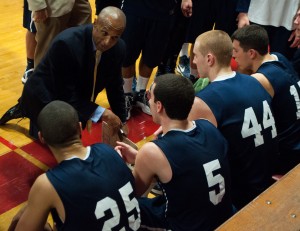
The Winningest Class in School History: Thompson, Wolfin, and Lynch
Jake Wolfin:
JH: Brilliant distributor and ball-handler, run to the roar mentality.
DH: A great point guard knows how to get his teammates involved; Jake Wolfin understood how to get the entire building involved.
Peter Lynch:
JH: Always found a way to score.
DH: Did more with his natural ability than any big man I’ve ever seen.
Nolan Thompson:
JH: Leader, tone-setter, elite shooter, shutdown defender beyond compare.
DH: He once got a standing ovation in Pepin Gymnasium for denying Shasha Brown the ball.
James Jensen:
JH: Love of competition, mature perspective and character.
DH: Toughest guy on the floor; most thoughtful off it.
Joey Kizel:
JH: Never conflated stardom with self importance; a playing style that was both magic and methodic; thrived in the moment.
DH: 20 years from now I’ll tell some kid his game reminds me of Joey Kizel’s and there will be no higher praise.
This post has covered exclusively basketball. If it wasn’t clear already, the basketball program was our blog’s heart and soul. But we were lucky enough to cover a football program led by one of the nation’s top quarterbacks, complemented by memorable stars on both sides of the ball, which went 14-2 over the past two seasons, tied for the best record in the conference over that time. This year, we again followed closely as the team exceeded expectations and finished 6-2, including a win over Trinity that ended Trinity’s legendary home winning streak. What were your favorite moments from the previous two years, and what are your condensed reflections on Middlebury and NESCAC football?
DH: The 2012 win over Amherst at home is among the best Middlebury sports wins I’ve ever witnessed. It was an incredible effort from the team, on both sides of the ball, to overcome a Trinity team that had embarrassed them the year before. The Foote-to-Minno touchdown and the Leedy game-winning interception are all-time great plays. Perhaps my favorite broadcasting moment happened when Matt Crimmins picked off Colby’s Justin Ciero and took it back to the end zone. The most amazing play I witnessed was the fumble return for touchdown against Bates when Crimmins picked up a bouncing ball in the backfield, ran it 70 yards before being caught by Tufts’ tight end Nick Kenyon and lateralling it back to Jared Onouye who had followed the play from behind and who took it the remaining 10 yards for the score, sealing the Middlebury victory and a 7-1 season. The trio of Mac Foote, Zach Driscoll and Billy Chapman were incredible during the 2012 season. Driscoll’s route-running, hands and explosiveness after the catch were remarkable. Chapman was probably the best tight end in Division III that year. And nobody was a better competitor or teammate than Mac Foote.
JH: This program has been better than any in the NESCAC except Amherst over the past three years, and the emergence of great players beyond Mac Foote has been especially impressive. The defense seems to get better every game, with more stars than we can keep track of at this point, and the offense excels at what seems impossible for the rest of the NESCAC: passing downfield consistently and effectively. In addition to record-breaking stats and well-deserved post-season honors, there are now a number of signature wins to mark this era—Amherst in 2012, Williams in 2012, Trinity in 2013, Trinity in 2014. Coach Ritter’s staff would receive my 2014 Coach of the Year vote for how far the depth of this program has come in the past four years.
What was your favorite Panther Nation post to write?
JH: The All-Conference teams and awards were so much fun to prepare, mostly because we learned so much in the process. We would usually start with some first impressions created independently, then go through the league statistics and our own notes and memories, moving players up and down tiers, stopping to note standouts whose performance might have gone unheralded to that point. Various arguments always sprung up: How much weight should we put on statistics? What is the appropriate balance of efficiency and production? What would a team have looked like without their most valuable player? What is the relationship between value and the standings? This process took many hours, and always left me feeling like I knew a lot more about the conference, and basketball, than when I began. I hope we were able to translate some of that in our written efforts to articulate these decisions.
The season previews, particularly the 2013-14 basketball preview, consumed the most time and were probably the best product. I loved surveying the conference in-depth in October (again, because of how much we learned in the process).
And it was great to share our radio interview with Middlebury President Ron Liebowitz on the blog. That he read our blog and gave us the time of day for the interview was flattering. The same goes for the 15-20 players who came through the WRMC studio to record interviews that we later shared here.
DH: The best posts were the ones we spent hours collaborating on, spent all night writing, finished, and went to bed somehow feeling even better than when we started. I can remember the excitement of putting together the season preview — the massive breakdown we did of every player on the team, every team in the conference and every game Middlebury would play. It’s always fun to think of the many different permutations of an upcoming season and speculate which lineups will have the best +/-.
As fun as thinking about the upcoming season was, looking back at the NESCAC season and determining our All-Conference teams and awards was better. Determining value in basketball is a very difficult thing to do, which makes clear reasoning and objectivity all the more important. Making our respective teams, coming back together, discussing the discrepancies in our decisions and creating consensus was a valuable exercise in thought. Ultimately, our combined effort making the case for Nolan Thompson as NESCAC Player of the Year was my favorite post(s) to write.
What is the future for coverage of Middlebury and NESCAC athletics?
JH: Some of our former contributors have created a blog called “Nothing But NESCAC” which provides thorough coverage of football, basketball, and baseball in the conference. I have enjoyed reading their material and hope that our readers are aware of that resource.
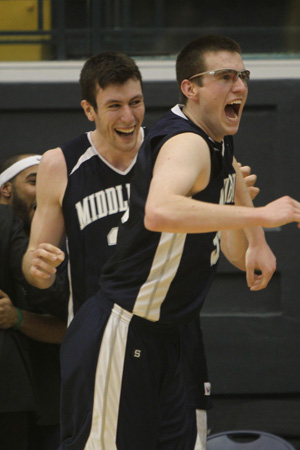 Soon, our access to this blog will be revoked, due to our creating it through Middlebury’s WordPress system. Our Twitter account, @MiddPantherBlog, will stay active, as a source for our coverage, thoughts, and analysis on Middlebury football and basketball. We know the teams well and will continue to follow closely.
Soon, our access to this blog will be revoked, due to our creating it through Middlebury’s WordPress system. Our Twitter account, @MiddPantherBlog, will stay active, as a source for our coverage, thoughts, and analysis on Middlebury football and basketball. We know the teams well and will continue to follow closely.
DH: Three-and-a-half years ago when I was writing a Middlebury/NBA comparison blog post on the Middlebury Campus website, I couldn’t have imagined what we would eventually create with Panther Nation. Hopefully we were able to bring value to the discussion of NESCAC basketball and football, but also know that we enjoyed this more than anyone could imagine. I certainly hope that others, like Nothing But NESCAC, can enjoy a similar experience and that there will be continued coverage of NESCAC athletics. There is a space for student-led coverage across all sports. NESCAC athletics has a tremendous following beyond football and basketball. For Jeff and me, those were the two sports for which we knew we could further the level of discourse, and hopefully we achieved that. But because there isn’t very much money in Division III coverage, there is a journalistic void for every single sport. Some, like Pat Coleman, have recognized that, and have worked tirelessly to provide greater coverage of the tremendous benefits of Division III athletics. But more work can, and should, be done. If you are an aspiring sports journalist — or have a passion for NESCAC athletics — help fill the void that wouldn’t exist (for better or for worse) if you attended a Division I school. It is immensely worthwhile.
